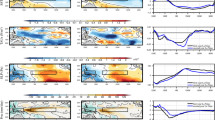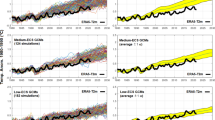Abstract
Regional anomalies of the surface climate over Europe are defined by a simultanous EOF-analysis of the normalized monthly mean sea level pressure, temperature and precipitation fields of 100 winters (December–February, 1887–1986) at 40 stations. The monthly amplitudes of the first EOF (about 25% of the total variance) are used as an index for the monthly winter climate anomaly. They characterize a high (low) pressure cell over central Europe associated with a positive (negative) temperature and precipitation anomaly over northern (central-southern) Europe as indicated by a northward (southward) shift of the tail end of the cross-Atlantic cyclone track. These patterns resemble the phenomenological anticyclonic (cyclonic) Grosswetter classification and the European blocking (enhanced zonal flow) regime. The second EOF is of similar magnitude and gives latitudinal corrections to these two basic flow regimes. The joint probability distribution of both amplitudes shows a weak bimodality mainly associated with the first EOF. Further insight into the underlying physical processes of the climate anomaly patterns in Europe is obtained from the extended Eliassen-Palm flux diagnostics of the barotropic transient eddy-mean flow interaction (Hoskins et al. 1983) and the stationary wave propagation (Plumb 1985). The diagnostics confined to the barotropic components and applied to the regression and the composite anomaly fields of the transient and stationary eddy flows of the 500 hPa geopotential (1946–87, north of 20°N) leads to the following results: (1) The bandpass filtered transient eddy variances of the 500 hPa geopotential show a shift of the cross-Atlantic storm track: In high (low) pressure situations over Europe the cross-Atlantic storm track intensity is enhanced (reduced) and its tail end is shifted northward (remains zonal); the North Pacific storm track extends further (less) eastward and thus closer to the west coast of North America. (2) The extreme high pressure system over Europe tends to be supported by an anomalous transient eddy forcing of the mean flow stream-function: it enhances the zonal wind to its north and generates anticyclonic vorticity about 10° upstream from its center. In the low pressure composite the anomalous cyclonic vorticity is generated reducing the zonal flow to its north. (3) The occurrence (lack) of a strong eastward stationary wave activity flux over the Atlantic is associated with the high (low) pressure situations over Europe. Finally, a positive feedback is conjectured between the stationary wavetrain modifying the tail end of the cross-Atlantic storm track and the transient eddies intensifying this anomaly.
Similar content being viewed by others
References
Blackmon ML, Lau N-C (1980) Regional characteristics of the northern hemisphere winter time circulation: a comparison of a GFDL general circulation model with observations. J Atmos Sci 37:497–514
Farrell BF (1989) Optimal exitation of baroclinic waves. J Atmos Sci 46:1193–1206
Fraedrich K (1990) European Großwetter during the warm and cold extremes of the El Niño/Southern Oscillation. Int J Climatol 10:21–31
Glowienka-Hense R, Hense A (1992) The effect of an Arctic Polynya on the Northern Hemisphere mean circulation and eddy regime: a numerical experiment. Clim Dyn 7:155–163
Hansen AR, Sutera A (1986) On the probability distribution of planetary scale atmospheric wave amplitude. J Atmos Sci 43:3250–3265
Held IM, Lyons SW, Nigam S (1989) Transients and the extratropical response to El Niño. J Atmos Sci 46:163–174
Hess P, Brezowsky H (1977) Katalog der Grosswetterlagen. Ber Dtsch Wetterdienst, Offenbach, FRG
Holopainen E (1984) Statistical local effect of synoptic scale transient eddies on time mean flow in the norther extratropics in winter. J Atmos Sci 41:2505–2515
Hoskins BJ, James IN, White GH (1983) The shape, propagation and mean-flow interaction of large-scale weather systems. J Atmos Sci 40:1595–1612
Karoly DJ, Plumb RA, Ting M (1989) Examples of the horizontal propagation of quasi-stationary waves. J Atmos Sci 46:2802–2811
Kiladis GN, Diaz HF (1989) Global climatic anomalies associated with extremes of the Southern Oscillation. J Climate 2:1069–1090
Kutzbach JE (1967) Empirical eigenvectors of sea level pressure, surface temperature and precipitation complexes over North America. J Appl Meteorol 6:791–802
Lau N-C (1988) Variability of the observed midlatitude storm tracks in relation to low-frequency changes in the circulation pattern. J Atmos Sci 45:2718–2743
Marks CJ (1988) Linear wavetrains in models of the stratosphere. Quart J Roy Met Soc 114:297–323
Metz W (1986) Transient cyclone-scale vorticity forcing of blocking highs. J Atmos Sci 43:1467–1483
Metz W, Lu M-M (1990) Storm track eddies in the atmosphere and in an ECMWF T21 climate model. Beitr Phys Atmosph 63:25–40
Mo KC, Pfaendtner J, Kalnay E (1987) A GCM study of the maintenance of the June 1982 blocking in the Southern Hemisphere. J Atmos Sci 44:1123–1142
Mo KC, Ghil M (1987) Statistics and dynamics of persistent anomalies. J Atmos Sci 44:877–901
Mullen SL (1987) Transient eddy forecing of blocking flows. J Atmos Sci 44:3–22
North GR, Bell TL, Cahalan RF, Moeng FM (1982) Sampling errors in the estimation of empirical orthogonal functions. Mon Wea Rev 110:699–706
Plumb RA (1985) On the three-dimensional propagation of stationary waves. J Atmos Sci 42:217–229
Robertson AW, Metz W (1990) Transient-eddy feedbacks derived from linear theory and observations. J Atmos Sci 47:2743–2764
Sutera A (1986) Probability density distribution of large scale atmospheric flow. Adv Geophys 29:319–338
Ting M, Held IM (1990) The stationary wave response to a tropical SST anomaly in an idealized GCM. J Atmos Sci 47:2546–2566
Trenberth KE (1986) An assessment of the impact of transient eddies on the zonal flow during a blocking episode using focalized Eliassen-Palm flux diagnostics. J Atmos Sci 43:2070–2087
Vautard R (1990) Multiple weather regimes over the North Atlantic: analysis of precursers and successors. Mon Wea Rev 118:2056–2081
Van Loon H, Rogers JC (1981) The Southern Oscillation; Part 2: Associations with changes in the middle troposphere in the northern winter. Mon Wea Rev 109:1163–1168
Wallace JM, Lim G-H, Blackmon ML (1988) On the relationship between cyclone tracks, anticyclone tracks and baroclinic wave-guides. J Atmos Sci 45:439–462
Wallace JM, Lau N-C (1985) On the role of barotropic energy conversions in the general circulation. Adv Geophys 28A:33–74
Author information
Authors and Affiliations
Rights and permissions
About this article
Cite this article
Fraedrich, K., Bantzer, C. & Burkhardt, U. Winter climate anomalies in Europe and their associated circulation at 500 hPa. Climate Dynamics 8, 161–175 (1993). https://doi.org/10.1007/BF00207963
Received:
Accepted:
Issue Date:
DOI: https://doi.org/10.1007/BF00207963




